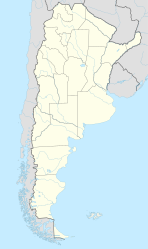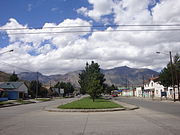Esquel
| Esquel | ||
|---|---|---|
| Town | ||

City Centre
|
||
|
||
| Location of Esquel in Argentina | ||
| Coordinates: 42°54′S 71°19′W / 42.900°S 71.317°WCoordinates: 42°54′S 71°19′W / 42.900°S 71.317°W | ||
| Country | Argentina | |
| Province | Chubut | |
| Department | Futaleufú | |
| Founded | February 25, 1906 | |
| Government | ||
| • Mayor | Sergio Ongarato (Cambiemos) | |
| Elevation | 563 m (1,847 ft) | |
| Population (2012) | ||
| • Total | 32,234 | |
| Time zone | ART (UTC-3) | |
| CPA base | U9200 | |
| Dialing code | +54 2945 | |
| Climate | Csb | |
| Website | esquel.gov.ar | |
Esquel is a town in the northwest of Chubut Province in Argentine Patagonia. It is located in Futaleufú Department, of which it is the government seat. The town's name derives from one of two Tehuelche words. One meaning "marsh" and the other meaning "land of burrs", which refers to the many thorny plants including the pimpinella and other herbaceous plants whose fruits, when ripe turn into prickly burrs that stick to the animals' skins and wool or people's clothes as a way of propagation.
History[edit]
The founding of the town dates back to the arrival of Welsh immigrants in Chubut in 1865. The settlement was created on 25 February 1906, as an extension of the Colonia 16 de Octubre, that also contains the town of Trevelin.
The city, the main town of the area, is located by the Esquel Stream and surrounded by the mountains La Zeta, La Cruz, Cerro 21 and La Hoya. La Hoya is known as a ski resort with good quality snow right through the spring. The Los Alerces National Park is 50 km (31 mi) northwest of the city.
Another important tourist attraction is the narrow-gauge train (with 75 cm between the rails), known as La Trochita locally and in English as The Old Patagonian Express after The Old Patagonian Express by Paul Theroux. It is said to be the only narrow-gauge long-distance train in operation and the southernmost railway in the world. The first fifty locomotives were made by Henschel & Son of Germany in 1922 and were originally modified to use fuel oil and steam. Later twenty-five locomotives were bought from the Baldwin Locomotive Works of Philadelphia.
The train remains authentic and in operation thanks to the effort of the team of workers at Talleres Ferroviarios El Maiten, that make a lot of pieces and parts by hand. The trains now run as a tourist excursion between Esquel and the small settlement of Nahuel Pan, located at the foot of the volcano of the same name, with other services all the way to El Maitén. Until 1993, the train ran all the way to the city of Ingeniero Jacobacci in Río Negro Province, from where trains ran to Viedma, Río Negro and from there to Buenos Aires, forming the General Roca railway.
|
According to the 2001 census [INDEC], the Esquel district had about 28,000 inhabitants, with one of the highest rates of growth in the province, mainly as result of the immigration of people from Buenos Aires, but also from other provinces. It has wide cement streets with sidewalks, and is clean and well maintained. Their hospital is the primary one for the zone and is often a destination for "Medical Tourism" from both foreigners and Porteños (residents of Buenos Aires) alike.
The townspeople have been in a long battle to prevent a gold mine being set up nearby, with concerns that the metal extraction will pollute the watercourse permanently and irreversibly. Although the mining companies were prohibited from producing mines in the area, there are still monthly street marches against the mines, and the issue never seems to feel fully settled.
In May 2009, Esquel twinned with Aberystwyth in Wales; with representatives of the Welsh town traveling to Argentina to participate in the signing of a charter formalising the link.
Esquel meteorite[edit]
In 1951 a farmer found a 755 kilograms (1,664 lb) meteorite, later called Esquel, while digging a hole for a water tank. When cut and polished, the meteorite showed beautiful yellowish olivine (peridot) crystals. The Esquel meteorite is known world wide among collectors and the scientific community.
Climate[edit]
Owing to its location on the immediate leeward side of the Andes, Esquel has a cool summer Mediterranean climate (Köppen Csb), with a rainfall pattern similar to central Chile.[1] Other climate systems, such as the Trewartha climate classification, place it within the oceanic zone (Do), like much of Western Europe and the Pacific Northwest of the United States. Temperatures are relatively cold for its climate due to its higher altitude.[1] Summers are mild with warm temperatures during the afternoon followed by cool nights.[2] The mean temperature during the summer is around 14 °C (57.2 °F).[1] It's the sunniest season, averaging as much as 10 hours of sunshine per day in January with an average of 7–8 clear days and only 5-7 overcast days.[1][3] Spring and fall are transition seasons featuring mild temperatures during the day and cool to cold nights.[2] Spring starts out with cool temperatures during the day and very cold nights which progressively becomes warmer.[2] Both spring and fall have highly variable weather.[4]
Winters vary from cool to cold with mean temperatures close to freezing while precipitation is high.[1] Temperatures regularly fall below freezing during the winter nights.[2] Winters are characterized by cloudy weather, averaging 11-13 overcast days from June to August.[3] Snow falls on average on twenty days each winter but usually doesn't stay on the ground for too long. The average date of the first frost occurs on March 7 while the average data of the last frost occurs on November 10 although frosts have been recorded in all months.[5]
The average relative humidity is 62%, ranging from a high of 77% in June and July to a low of 49% in January.[6] Summers have lower humidity due to higher temperatures.[1] Most of the wind comes from the west or the southwest with calm days being uncommon.[1] The relief modifies the wind speeds with southern areas receiving more wind than the north.[1] Mean wind speeds range from 17.4 km/h (10.8 mph) in July to 30.4 km/h (18.9 mph) in December with summers being more windy than winters.[1][2] Esquel receives an average annual precipitation of 504.2 millimetres (20 in) a year; much of it being concentrated in the winter months.[1] Esquel, which lies in the zone of transition between the wetter Andes to the west and the steppes to the east,[1] records higher precipitation in the town than in the airport located 13 kilometers to the east.[7] It is estimated that Esquel receives an average of 7 hours of sunshine per day, ranging from a high of 10 hours in January to a low of 5 hours in July.[1]
| Climate data for Esquel (1961–1990, extremes 1901–1990) | |||||||||||||
|---|---|---|---|---|---|---|---|---|---|---|---|---|---|
| Month | Jan | Feb | Mar | Apr | May | Jun | Jul | Aug | Sep | Oct | Nov | Dec | Year |
| Record high °C (°F) | 38.6 (101.5) |
35.2 (95.4) |
32.2 (90) |
27.0 (80.6) |
22.3 (72.1) |
21.2 (70.2) |
20.7 (69.3) |
18.7 (65.7) |
23.5 (74.3) |
29.6 (85.3) |
32.6 (90.7) |
35.0 (95) |
38.6 (101.5) |
| Average high °C (°F) | 21.0 (69.8) |
21.2 (70.2) |
18.9 (66) |
14.8 (58.6) |
10.3 (50.5) |
6.5 (43.7) |
6.3 (43.3) |
8.4 (47.1) |
11.5 (52.7) |
14.5 (58.1) |
17.7 (63.9) |
19.7 (67.5) |
14.2 (57.6) |
| Daily mean °C (°F) | 14.3 (57.7) |
14.3 (57.7) |
12.0 (53.6) |
8.3 (46.9) |
5.1 (41.2) |
2.0 (35.6) |
1.6 (34.9) |
3.1 (37.6) |
5.2 (41.4) |
8.2 (46.8) |
11.2 (52.2) |
13.2 (55.8) |
8.2 (46.8) |
| Average low °C (°F) | 7.6 (45.7) |
6.8 (44.2) |
4.9 (40.8) |
2.2 (36) |
0.2 (32.4) |
−2.5 (27.5) |
−2.9 (26.8) |
−1.6 (29.1) |
−0.6 (30.9) |
1.6 (34.9) |
4.6 (40.3) |
6.4 (43.5) |
2.2 (36) |
| Record low °C (°F) | −5.4 (22.3) |
−4.6 (23.7) |
−7.0 (19.4) |
−11.5 (11.3) |
−12.5 (9.5) |
−21.2 (−6.2) |
−22.8 (−9) |
−18.1 (−0.6) |
−14.8 (5.4) |
−10.3 (13.5) |
−7.0 (19.4) |
−4.5 (23.9) |
−22.8 (−9) |
| Average precipitation mm (inches) | 22.4 (0.882) |
17.9 (0.705) |
20.8 (0.819) |
38.0 (1.496) |
78.9 (3.106) |
85.9 (3.382) |
73.5 (2.894) |
57.7 (2.272) |
37.8 (1.488) |
25.9 (1.02) |
19.5 (0.768) |
25.9 (1.02) |
504.2 (19.85) |
| Average precipitation days (≥ 0.1 mm) | 4 | 4 | 5 | 6 | 10 | 10 | 11 | 9 | 7 | 6 | 4 | 5 | 81 |
| Average snowy days | 0.1 | 0.2 | 0.2 | 0.5 | 2 | 5 | 6 | 4 | 3 | 0.9 | 0.2 | 0.3 | 22.4 |
| Average relative humidity (%) | 49 | 52 | 56 | 63 | 72 | 77 | 77 | 72 | 63 | 56 | 51 | 50 | 62 |
| Mean monthly sunshine hours | 306 | 247 | 217 | 157 | 109 | 78 | 108 | 134 | 187 | 246 | 256 | 278 | 2,324 |
| Percent possible sunshine | 67 | 64 | 57 | 48 | 36 | 27 | 37 | 41 | 53 | 60 | 59 | 59 | 51 |
| Source #1: NOAA,[6] Secretaria de Mineria[3] | |||||||||||||
| Source #2: Servicio Meteorológico Nacional (precipitation days),[8] FAO (sun only),[9] UNLP (snowfall data)[10] | |||||||||||||
See also[edit]
References[edit]
- ^ a b c d e f g h i j k l "Provincia de Chubut–Clima Y Metéorologia" (in Spanish). Secretaria de Mineria de la Nacion (Argentina). Archived from the original on April 17, 2015. Retrieved October 6, 2015.
- ^ a b c d e "Datos Estadísticos (Período 1981-1990)" (in Spanish). Servicio Meteorológico Nacional. Retrieved October 6, 2015.
- ^ a b c "Provincia de Chubut - Clima Y Meteorologia: Datos Meteorologicos Y Pluviometicos" (in Spanish). Secretaria de Mineria de la Nacion (Argentina). Archived from the original on January 19, 2015. Retrieved March 31, 2015.
- ^ "El Clima en Esquel" (in Spanish). Secretaría de Turismo de la Ciudad de Esquel. Retrieved October 6, 2015.
- ^ "Esquel, Chubut". Estadísticas meteorológicas decadiales (in Spanish). Oficina de Riesgo Agropecuario. Retrieved October 6, 2015.
- ^ a b "Esquel Aero Climate Normals 1961-1990". National Oceanic and Atmospheric Administration. Retrieved March 31, 2015.
- ^ Trees in Patagonia 2008, p. 13.
- ^ "Valores Medios de Temperatura y Precipitación-Chubut: Esquel" (in Spanish). Servicio Meteorológico Nacional. Retrieved March 31, 2015.
- ^ "Cuadro 13: Sumas Mensuales y Anuales de las Horas de Sol Efectivas y Porcentaje de los Totales de Horas de Sol" (PDF). Estudio Sobre la Rehabilitacion de Tierras en el Valle de Viedma: Informed Final–Volumen II (in Spanish). Food and Agriculture Organization. p. 97. Retrieved July 13, 2015.
- ^ "Datos bioclimáticos de 173 localidades argentinas". Atlas Bioclimáticos (in Spanish). Universidad Nacional de La Plata. Retrieved October 13, 2015.
Books[edit]
- Gut, Bernardo (2008). Trees in Patagonia. Springer. ISBN 978-3-7643-8837-9.
External links[edit]
| Wikimedia Commons has media related to Esquel. |
- Project-Hiraeth – Documents the stories of the Welsh colony in Patagonia, Argentina through film, text and illustration.
- Municipal information: Municipal Affairs Federal Institute (IFAM), Municipal Affairs Secretariat, Ministry of Interior, Argentina. (Spanish)
- News tourism information, photographs
- Municipality of Esquel - General, government and tourism information (in English and Spanish).
- La Trochita





